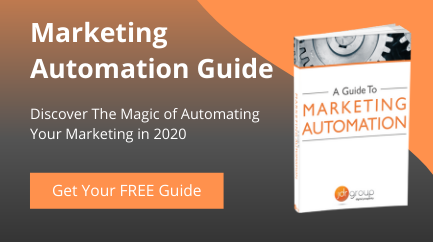How To Successfully Implement Marketing Automation
by Daniel Baker on 05-Dec-2017 10:19:28
What Is Marketing Automation?
Marketing Automation technology and software helps to streamline repetitive marketing tasks to increase productivity and efficiency within both the sales and marketing sectors of your business. The aim is to ultimately attract new leads, generate sales and increase revenue in the easiest way possible.
Many surveyed companies have on average 23% of their total sales to thank automated email marketing for and for every £1 spent on automated email marketing, this proven successful strategy generates an average £38 in ROI. Therefore you are six times more likely to create a lead from an email than a Twitter link.
Marketing Automation Benefits
- Boosted sales readiness of your leads
- Improved marketing and sales productivity and efficiency
- Increased sales revenues
- Increased customer engagement through enhanced targeting
- Deepened and maintained customer relationships
- Can see how each person is interacting with your brand
- Frees up time to focus on closing the leads and generating a sale with the leads that matter
- Helps you to see which marketing campaigns bring in the most sales
Examples Of Marketing Automation Software
- Hubspot
- Sharpspring
- Active Campaign
- Pardot
Here's How To Successfully Implement Marketing Automation:
1) Invest In Training
Introducing a Marketing Automation strategy into your business is an exciting process, however it can often be quite daunting for many of your employees who are not familiar with this particular software. Therefore investing in some training for your staff will be very beneficial as it will boost confidence along with lots of other long term advantages.
Providing extra training for your team is a way of proving to them that you are committed to their success, which will ultimately improve performance of employees resulting in a more profitable business overall.
2) Be Realistic
It's massively important to be positive and to have a big vision for your company, however there is a fine line between extreme optimism and biting off more than you can chew.
In order to successfully implement Marketing Automation, baby steps are the answer. It is not a good approach to overwhelm your marketing team, especially with a new project.
Aim to hit small but regular targets, this will enable the business to achieve the larger goals in the bigger picture.
3) Have A Plan
It is absolutely critical that there be a plan and a strategy in place when implementing a new marketing campaign such as Marketing Automation. This is so no jobs get left behind and everyone involved with the project is on the same page. Some things to consider in your plan include:
- Identifying the admins, users and rules for governance
- Working with sales to define what constitutes a qualified lead
- Determining if/how the platform will integrate with other systems
- Migration of contacts, opt-outs and hard bounce list from current email platform
- Integrating contact forms/subscription forms/lead gen forms on your website
- Setting up subscription management
- Adding visitor tracking code to your website
- Designing email and landing page templates to match your brand
4) Data Analysis
Your new business database will be constantly accumulating information and it is vital that you utilise this and analyse as much as you can. This is valuable material that will be the making of the success of your business' marketing automation. From this data you can create client segments and really understand their wants and needs.
Here are a few other articles related to Marketing Automation than you may be interested in:
- How Much Does Email Marketing Automation Cost?
- 12 Reasons Why Marketing Automation Works For Small Businesses
- Marketing Automation Tools Comparison – 4 Of The Best Platforms
Hopefully these steps have helped you understand how to successfully implement Marketing Automation a little more and its purpose. If you have any queries, please comment below or call us on 01332 343281 for an informal chat.
- Inbound Marketing (SEO, PPC, Social Media, Video) (824)
- Strategy (363)
- Sales & CRM (195)
- Marketing Automation & Email Marketing (190)
- Business Growth (164)
- Website Design (160)
- Hubspot (138)
- Lead Generation (115)
- Google Adwords (98)
- Content Marketing (94)
- Conversion (48)
- Case Studies (47)
- News (47)
- Ecommerce (39)
- Webinars (34)
- SEO (24)
- AI (20)
- Events (19)
- Video (17)
- LinkedIn Advertising (15)
- Video Selling (15)
- Software training (13)
- Niche business marketing (11)
- The Digital Prosperity Podcast (10)
- Facebook Advertising (6)
- HubSpot Case Studies (5)
- December 2025 (10)
- November 2025 (6)
- October 2025 (17)
- September 2025 (16)
- August 2025 (14)
- July 2025 (14)
- June 2025 (5)
- May 2025 (19)
- April 2025 (15)
- March 2025 (13)
- February 2025 (13)
- January 2025 (8)
- December 2024 (2)
- November 2024 (4)
- October 2024 (21)
- September 2024 (4)
- August 2024 (8)
- July 2024 (14)
- June 2024 (16)
- May 2024 (25)
- April 2024 (15)
- March 2024 (18)
- February 2024 (5)
- January 2024 (10)
- December 2023 (6)
- November 2023 (10)
- October 2023 (13)
- September 2023 (12)
- August 2023 (14)
- July 2023 (13)
- June 2023 (14)
- May 2023 (15)
- April 2023 (13)
- March 2023 (14)
- February 2023 (13)
- January 2023 (15)
- December 2022 (13)
- November 2022 (6)
- October 2022 (8)
- September 2022 (22)
- August 2022 (15)
- July 2022 (13)
- June 2022 (16)
- May 2022 (14)
- April 2022 (16)
- March 2022 (17)
- February 2022 (11)
- January 2022 (8)
- December 2021 (6)
- November 2021 (7)
- October 2021 (11)
- September 2021 (10)
- August 2021 (7)
- July 2021 (7)
- June 2021 (4)
- May 2021 (4)
- April 2021 (1)
- March 2021 (3)
- February 2021 (5)
- January 2021 (4)
- December 2020 (7)
- November 2020 (6)
- October 2020 (5)
- September 2020 (9)
- August 2020 (18)
- July 2020 (17)
- June 2020 (17)
- May 2020 (10)
- April 2020 (21)
- March 2020 (24)
- February 2020 (21)
- January 2020 (12)
- December 2019 (23)
- November 2019 (12)
- October 2019 (14)
- September 2019 (16)
- August 2019 (15)
- July 2019 (13)
- June 2019 (6)
- May 2019 (8)
- April 2019 (4)
- March 2019 (2)
- February 2019 (2)
- January 2019 (2)
- December 2018 (3)
- November 2018 (24)
- September 2018 (11)
- August 2018 (9)
- June 2018 (3)
- May 2018 (6)
- April 2018 (14)
- March 2018 (12)
- February 2018 (16)
- January 2018 (15)
- December 2017 (15)
- November 2017 (18)
- October 2017 (23)
- September 2017 (19)
- August 2017 (28)
- July 2017 (27)
- June 2017 (25)
- May 2017 (18)
- April 2017 (17)
- March 2017 (16)
- February 2017 (17)
- January 2017 (14)
- December 2016 (21)
- November 2016 (27)
- October 2016 (25)
- September 2016 (16)
- August 2016 (20)
- July 2016 (19)
- June 2016 (14)
- May 2016 (20)
- April 2016 (24)
- March 2016 (22)
- February 2016 (28)
- January 2016 (27)
- December 2015 (28)
- November 2015 (19)
- October 2015 (9)
- September 2015 (12)
- August 2015 (5)
- July 2015 (1)
- June 2015 (10)
- May 2015 (3)
- April 2015 (11)
- March 2015 (14)
- February 2015 (15)
- January 2015 (12)
- December 2014 (2)
- November 2014 (23)
- October 2014 (2)
- September 2014 (2)
- August 2014 (2)
- July 2014 (2)
- June 2014 (7)
- May 2014 (14)
- April 2014 (14)
- March 2014 (7)
- February 2014 (2)
- January 2014 (7)
- December 2013 (9)
- November 2013 (14)
- October 2013 (17)
- September 2013 (3)
- August 2013 (6)
- July 2013 (8)
- June 2013 (4)
- May 2013 (3)
- April 2013 (6)
- March 2013 (6)
- February 2013 (7)
- January 2013 (5)
- December 2012 (3)
- November 2012 (2)
- September 2012 (1)
Subscribe by email
You May Also Like
These Related Blogs

Replay: How To Use The HubSpot Prospecting WorkSpace
The Prospecting Workspace is a new addition to Sales Hub, and gives you a daily workspace to manage your leads and sales tasks. In this webinar you'll …

Replay: How To Manage Salespeople With HubSpot (HubSpot Masterclass)





